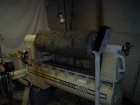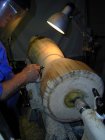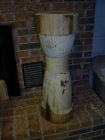I have successfully used just a 1” spur on 16” diameter x up to ~17” long green logs, and used a cone center. It does require paying attention to the chip load and interrupted cut impact load. As mentioned the tailstock needs to hold very well, and pressure on the wood checked often with green wood, as the cone will easily push into the wet wood.
I have also used a 2-1/2” Elio drive which works better than the 1” spur, but I’m moving away from spindle taper mounted drives with large projects due to concern over wear of the taper. I have a Nova jumbo center on the way - it screws onto the spindle. There are other options as well. Even a small face plate will work well to drive with, but I find it to be a chore to get the TS cone where I want it and a properly mounted faceplate, so I dont use them starting out. For hollowing I mount the work between centers, adjust orientation, turn a slightly concave surface and mount the faceplate. Another option is mount between centers long enough to turn a tenon, and then mount in a chuck.
Per previous comments, hopefully you have built some knowledge and experience by stepping up thru larger and larger log blanks.



